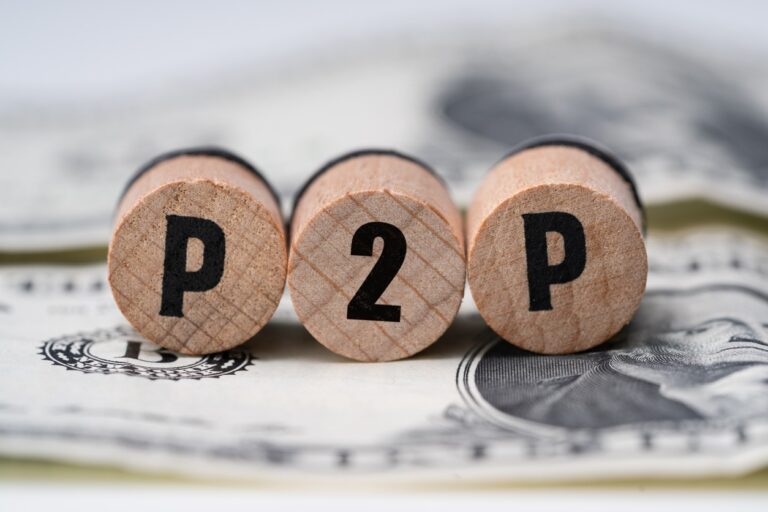On this page
What's next
Earn a high-yield savings rate with JG Wentworth Debt Relief
Peer to peer (P2P) loans are a form of lending that bypasses banks and traditional financial institutions. Instead of borrowing from a bank, individuals borrow money directly from other individuals through an online platform. These platforms act as a marketplace, connecting people who want to invest with people who need to borrow.
Over the last two decades, peer-to-peer lending has grown from a niche experiment into a significant part of the global lending industry. It has provided borrowers with alternative access to funds and given investors opportunities for returns outside of stocks or bonds.
*This information is provided for educational and informational purposes only. Such information or materials do not constitute and are not intended to provide legal, accounting, or tax advice and should not be relied on in that respect. We suggest that You consult an attorney, accountant, and/or financial advisor to answer any financial or legal questions. Loan eligibility and terms vary by lender and jurisdiction.
How Peer to Peer Loans Work
P2P lending is made possible by specialized platforms such as Prosper, LendingClub, Funding Circle, and Upstart. These platforms handle the administration while leaving the capital to flow between individuals.
- Borrower Application
- A borrower applies for a loan on the platform, providing personal details, income information, and credit history.
- The platform evaluates the application and assigns a risk rating or credit grade.
- Listing on the Marketplace
- The loan request is listed for potential investors to review.
- Borrowers may specify the purpose (debt consolidation, business funding, medical bills, etc.).
- Investor Funding
- Individual investors choose which loans to fund, often contributing small amounts across many loans to spread risk.
- A single borrower may have dozens or even hundreds of investors.
- Loan Issuance
- Once fully funded, the loan is disbursed to the borrower.
- Borrowers make fixed monthly payments to the platform, which distributes funds to investors.
- Servicing and Collection
- Platforms handle payment processing and, in cases of default, collection efforts.
Apply for a personal loan
Apply for a personal loan
Advantages of Peer-to-Peer Loans
For Borrowers
- Access to Funds: Borrowers who may not qualify for bank loans can sometimes find financing through P2P platforms.
- Competitive Rates: Depending on creditworthiness, borrowers may secure lower interest rates than credit cards or personal loans from banks.
- Flexibility: Loan purposes are often broader, ranging from debt consolidation to small business financing.
For Investors
- Attractive Returns: Returns can be higher than traditional savings accounts or government bonds.
- Diversification: Investors can spread capital across hundreds of loans, reducing the impact of a single default.
- Transparency: Platforms provide clear credit ratings, borrower information, and risk data.
Risks of Peer-to-Peer Loans
Borrower Risks
- High Interest for Riskier Borrowers: Those with lower credit scores may face steep rates.
- Impact on Credit Score: Defaults are reported to credit bureaus, harming future borrowing ability.
- Fees: Some platforms charge origination fees or penalties for late payments.
Investor Risks
- Default Risk: Borrowers can fail to repay, leading to loss of principal.
- Platform Risk: If the lending platform itself collapses, investors may have difficulty recouping funds.
- Liquidity Limitations: Unlike stocks or ETFs, loans are not always easy to sell before maturity.
Typical Uses for Peer-to-Peer Loans
- Debt Consolidation: Paying off multiple high-interest debts with a single structured loan.
- Medical Expenses: Covering bills not handled by insurance.
- Business Funding: Small businesses often turn to P2P platforms when banks decline loans.
- Home Improvements: Financing projects that add value to property.
- Education Costs: Supplementing tuition or certification expenses.
The Regulatory Landscape
Regulation of P2P lending varies widely:
- In the United States, platforms must register with the Securities and Exchange Commission (SEC) and adhere to state lending laws.
- In the United Kingdom, the Financial Conduct Authority (FCA) oversees peer to peer platforms.
- In other regions, regulations are still developing, and risk levels can vary significantly.
Borrowers and investors should ensure that any platform they use is registered, licensed, and compliant with local regulations.
How Borrowers Can Qualify
Approval criteria differ across platforms, but common factors include:
- Credit score and history
- Debt-to-income ratio
- Employment and income stability
- Loan purpose
Some newer platforms use alternative data, such as education level, job history, or even online behaviors, to assess risk.
How Investors Can Get Started
- Account Setup: Investors sign up and fund their platform account.
- Loan Selection: Investors choose manually or use automated investing tools that allocate funds based on risk preference.
- Diversification Strategy: Spreading investments across dozens or hundreds of loans is considered best practice.
- Monitoring: Investors can track returns, defaults, and reinvest repayments.
Peer to Peer vs Traditional Loans
Feature | Peer to Peer Loan | Bank Loan |
Source of Funds | Individual investors | Bank’s capital reserves |
Approval Process | Platform-driven, often faster | More stringent underwriting |
Rates | Vary by credit grade, sometimes lower | May be higher or lower depending on credit |
Regulation | Evolving, platform-specific | Heavily regulated |
Flexibility | Wide variety of loan purposes | Often limited to defined products |
The Future of Peer-to-Peer Lending
The industry continues to evolve. Some platforms have shifted to institutional investors rather than individuals, blurring the original peer to peer concept. Fintech innovation, AI-driven credit assessments, and blockchain-based lending systems may further reshape the space.
Despite challenges, demand for alternative lending remains strong, suggesting peer-to-peer loans will continue to play a role in consumer and small business finance.
Key Takeaways
- Peer to peer lending connects borrowers directly with investors through online platforms.
- Borrowers may benefit from competitive rates and easier access to funds.
- Investors can earn attractive returns but face real risks of default and limited liquidity.
- Due diligence is critical for both parties, especially when selecting a platform.
About the author
Recommended reading for you
*Any information provided on this site is for educational purposes only. JGW Connects, LLC is not an agent of you or any third party advertiser on this website. You should rely on your own judgement in deciding which available product, terms and provider that best suits your personal financial requirements. We do not offer financial advice, advisory or brokerage services. We recommend that you consult with our own independent advisors regarding these products and services
JGW Connects, LLC is an independent, advertising-supported comparison site and marketing lead generator and does not play a role in decisioning for any of the third party products advertised on this webpage. JGW Connects, LLC and the JG Wentworth Company family of companies are not affiliated with the companies advertising on this webpage. You are not charged for our services. JGW Connects, LLC may receive a referral fee or other affiliate fee for connecting you with these third-party companies or upon you contracting with a third-party company. We do not make any guarantees that these are the only providers in the marketplace, or that their products or services will meet your needs. The products and services presented to you may or may not be the best, or only options, available.
JGW Connects does not provide any of the products or services advertised and does not make any decisions regarding your eligibility for those products or services. All decisions regarding approval or denial of a particular product or service are the responsibility of the participating company and will vary based upon your particular financial situation, and criteria determined by the company to whom you are matched. Not all consumers will qualify for the advertised rates and terms.







